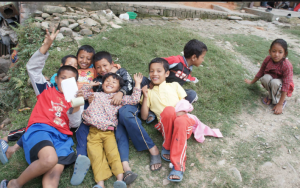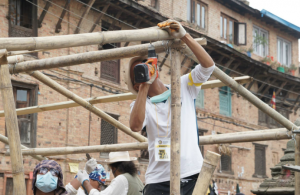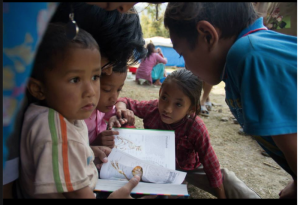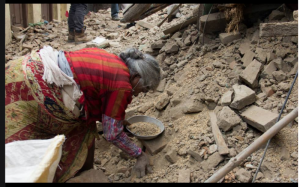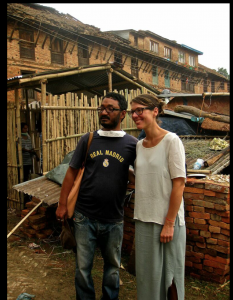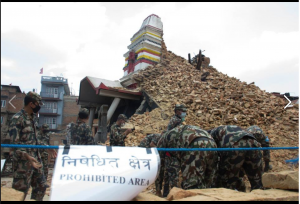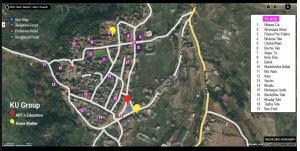Patenschaft in Heidelberg: Christiane Brosius, mit Nadine Plachta
Bungamati, südlich von Patan gelegen, ist eine bezaubernde Kleinstadt mit ca. 6000 Einwohnern – ‚gewesen’. Die Altstadt aus dem 16 Jahrhundert ist vom Erdbeben im April fast vollkommen zerstört worden. Schätzungen gehen davon aus, dass circa 1200 Familien (d.h. 4-6000 Menschen) obdachlos geworden sind. Auch wenn es im direkten Einzugsgebiet der Grosstadt liegt, so ist die Hilfe an dem Geburtstort des Roten Matsyendranath, einer der wichtigsten Gottheiten der ethnischen Gruppe der Newars, dort (noch) nicht angekommen. Sujan Chitrakar, Professor für Kunst und Design an der Kathmandu Universität, setzt sich nun unermüdlich für den Wiederaufbau – auf lange Sicht – und für Sofortmassnahmen für die Bevölkerung – auf kurze Sicht – ein. Er und seine Studenten, insgesamt 100 Freiwillige, sind ab dem 6. Mai im Einsatz, um temporäre Unterkünfte zu errichten, die Berge von Schutt zu entfernen, die Landbevölkerung mit Informationen, Koordinationshilfe und Zusammenarbeit zu helfen. Besonders im Fokus sind dabei alleinstehende alte Menschen, um die sich weniger gekümmert wird, und traumatisierte Kinder. Auf längere Zeit hin soll ein Masterplan entwickelt werden, der den Wiederaufbau der Stadt ermöglicht.
Die Heidelberger Ethnologin Christiane Brosius arbeitet seit einigen Jahren mit Sujan Chitrakar zusammen. Nadine Plachta, die Leiterin der Aussenstelle des Südasieninstituts, verfolgt die Vorbereitungen zu diesem Projekt genau und schreibt folgendes: „Sein Fokus liegt auf denjenigen älteren Menschen, die keinen Familienanschluss oder entfernte Verwandte besitzen. D.h. es handelt sich um Personen, die auf keine Unterstützung oder Rückhalt vertrauen können und sich aufgrund ihres fortgeschrittenen Lebensalters auch nur schwer selbst helfen können. Sujan baut temporäre Unterkünfte und Sanitäranlagen für sie auf, die 1-2 Jahre halten sollen und aus denen evtl. ein Altersheim oder eine Elders Community entstehen kann. … Neben dieser Wiederaufbauhilfe, kümmern sich die Studenten auch um Kinder. Sie leisten Traumabewältigung durch Mal-Workshops, bringen Zeichenmaterialien mit und lassen die Kinder die Erlebnisse zeichen, hören ihren Geschichten zu, zeichnen sie auf.“ (5.5.15) Plachta wird regelmässig vor Ort sein und das Projekt dokumentieren. Siehe die facebook-Seite der Gruppe sowie den regelmässigen Report von Christiane Brosius). Seit dem 9.6.2015 gibt es einen Blog zur Initiative, gemacht von den Voluntären des Projektes.
Eine Karte, gemacht von einem Studenten der Kathmandu Universität, auf der zur Orientierung einige der wichtigen Orte eingezeichnet sind, denn die meisten Häuser in Bungamati sind zerstört. Ausserdem sind die beiden temporären Unterkünfte gezeigt, die am ersten Tag gebaut werden sollten – und an Tag 2 stehen.
Sujan Chitrakar (SC) äußert sich in einem Interview mit Nadine Plachta (NP), der Aussenstellenleiterin, zu der Arbeit, die er koordiniert und die zu einem Grossteil mit der freiwilligen Hilfe von Studierenden der Kathmandu University, geleistet wird, und inzwischen (3.7.) fast zwei Monate anhält. Hier ein Ausschnitt aus dem Interview 2 Wochen nach dem ersten Erdbeben am 24.4.2015 (Anmerkungen Christiane Brosius: CB):
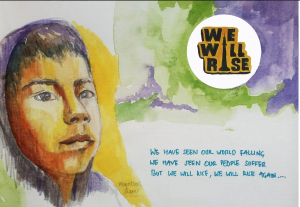
SC: „There are many people who are still facing those kinds of trauma, not just because they have lost their house and their property, also because the experience they had was terrible, you know, they are scared of their own houses. And how things are in Nepal – people invest their live in one house and when it goes, there is nothing left. The attachment with the property is very intense – it is like that anywhere in the world I guess. So even every brick counts for them, it’s for them, it’s like an engagement for attachment, if you see someone fighting for every brick, you have to be aware that every brick has a history with their live. So when that’s crumbling and when that’s not safe for them, it’s a problem for them. So with that thing (the suicide) happening yesterday we are still thinking how we can cope with that post-trauma situation. We have many things planned -we want to go at least for a longer period of time, we don’t want to go parachuting everywhere and try to put our banner but we are doing what we can, and develop a role model, to see how an institute (he refers to the Department of Art & Design that he is heading, CB) can make a change, rather than going around and having lots of coverage. We are active in small places.
NP: How did it come that you chose Bungamati? SC: … Bungamati, it’s in Lalitpur an it’s a suburb town and we thought why not go to Bungamati, because we heard that Bungamati was very badly hit and there is serious sanitation problem also. … There was one comment by a person that since we were artists we should go and maybe paint some signs, or maybe give information. Then it just clicked in our mind that no, art this is not just like this: we can do more than what people think we are supposed to do. So we thought we should adopt Bungamati in such a way that we contribute to Bungamati on the long run, you know, not just coming here and parachuting in. Have small things to do for a change. So we thought Bungamati would be the ideal place for us, for a few reasons: One is, it’s twelve years of celebration of Matsyendranath (this is the most important procession undertaken by Newar people in the Kathmandu Valley, where every 12th year, the procession chariot starts from Bungamati, the birthplace of Lord Matsyendranath, and is pulled to Patan, CB) – and there are lots of artisants. They’re skilled people, but they haven’t been in the limelight. There are so many craftsmen over there, and so many people are active during their freetime, they weave, for instance. Like this, in a way Bungamati is small and underestimatet town, with lots of craftsmen and expertise around. Thirdly, Bungamati is just a few kilometers away from Hattiban (where the art college is, albeit destroyed after the earthquake, CB). So if I have to mobilise my students I cannot take to them to Ghorka, so Bungamati is very close, just few kilometers away (…), so for me, choosing Bungamati is also encouraging all of our students who can come here. And the fourth thing is that our school is in Lalitpur, and Bungamati is in Lalitpur. That has cultural importance, historical importance, artistic importance – and we can contribute to that. So we thought that why not can an art institution build something for them, and for the future and so, rather than just building a shelter. A shelter is not our main agenda, but Bungamati (as such, CB), you know. So we are very stubborn with all this, insanely stubborn (laughs).
NP: But was it clear for you from the beginning that you want to mobilise your students for a long-term project? Or did that come gradually after you went to Bungamati? SC: For me it’s always been very easy to work with my students, I have always done this. Most of the projects I did, I did with my students. Ideally, if I have to do that my students are always there to support for the good cause, you know, so in so many other programs, our students have proved that they can do it. So I really believe in their capacity, so all I need is just to mobilise and channelize their energy you know, so that has been my previous idea. But this earthquake I think is kind of a turning point for Nepal, Nepali momentum, the growth of the Nepali momentum can not be the same as two weeks back (before the earthquake, CB). It has completely changed the whole society. So, for me, like, I don’t think we can resume our normal life, our life has taken different route now. So as an academic institution I believe I’d be wrong if I teach a textbook now, that has been prescribed by a committee or by the government. I think we need to revise or revamp that whole system of learning to match this crisis. So I really wanted to have our students to contribute to Bungamati like see how we can be part of this developing process, you know. And this is a tremendous opportunity for us, we’re trying to rebuild a country you know, and if we just go back and stay back we will become like a stupid person on art. So this is a chance, so why not make use of it because if we can, we can do it. So then I thought why not focus on Bungamati because so many people scattered around you know, and even I thought so many of friends who were in this relief distributing materials – everywhere, they have this crisis, they couldn’t build a rapport with people. When I went to Bungamati and tried to talk to people they didn’t have any information, so I thought that’s the wrong way of doing it, you know, so if we stick with Bungamati I would know people around, I would slowly build up rapport. If we can contribute in that particular area, then it would be very helpful, rather then going just and bringing support. So that’s why we decided we won’t go around, focus on Bungamati, people can take of other places, we will try to devote our time here, try to create a role for ourselves, not just for others. So that’s why we focus on Bungamati, I think for me it’s become easier, we don’t have to think of other stuff like that and it becomes more focused at least for the time being.
Zu den Paten in Heidelberg: Christiane Brosius arbeitet seit knapp 4 Jahren in und über Nepal. Hier verfolgt sie zwei Forschungen; die junge Kunstszene im Kathmandutal sowie Altern und Mobilität in der Stadt Patan. Im letzten Projekt arbeitet auch Roberta Mandoki. Nadine Plachta ist Aussenstellenleiterin des SAI in Kathmandu und betreut neben dem Projekt zu der vom Erdbeben betroffenen Tsum-Region auch „Rebuilding Bungamati“ und, zusammen mit Christiane, ein weiteres Künstlerprojekt zur Betreuung von traumatisierten Kindern in Bhaktapur.
